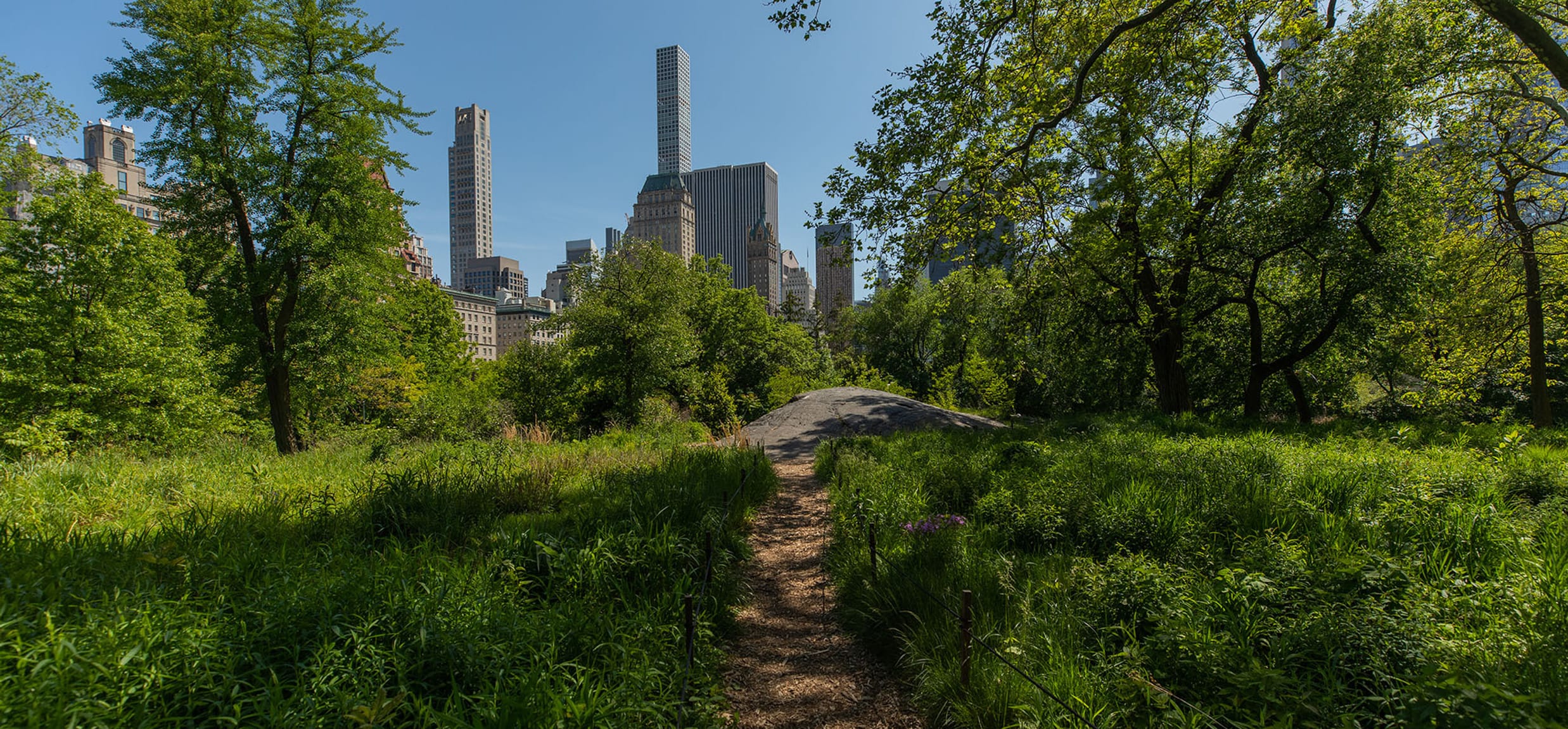Magazine
A Native Meadow in Progress, the Dene Slope Opens to the Public

The Dene Slope, a vibrant native meadow that features a trail with rustic seating and stunning views, is now open to the public. West of Billy Johnson Playground and just south of the Balto statue, the Dene Slope is a 1.25-acre area that was previously a weedy, eroded hillside. Now, it’s a growing meadow, peaceful rest stop for visitors, and hub for diverse wildlife.
Creating the Dene Slope
A meadow is a field populated with tall grasses and herbaceous plants. Though the first several years of creating a native meadow take a lot of work—primarily planting, weeding, and watering—they are quite low-maintenance once established. It takes three to five growing seasons to establish a meadow. Once established, tall meadow grasses prevent self-seeding invasive species from taking over, and they don’t require mowing. In these ways, native meadows can be less resource-intensive to maintain than lawns.

Gardener Mimi Gunderson and volunteers have been planting, weeding, and watering in the Dene Slope to prepare for its opening.
The Dene Slope contains rocky, dry soil—not ideal as a picnicking lawn, and difficult to mow because of its steep terrain. Therefore, it provided the perfect spot for the Conservancy to introduce a native meadow, which can thrive in almost any environment. Although the North Meadow Butterfly Gardens also feature native grasses and plants, the Dene Slope is the largest meadow of its kind in Central Park.
Now in its second growing season, the Dene Slope is showing a diverse variety of blooms. The Conservancy planted an abundance of native flowers in the meadow such as white false indigo, showy tick trefoil, common yarrow, lanceleaf coreopsis, hairy beardtongue, and button eryngo. Other native flowers that weren’t planted but have appeared include swamp milkweed, common boneset, cardinal flower, and blue vervain.
The Dene Slope’s gardener, Mimi Gunderson, and roughly a dozen volunteers have worked for over two years to get it to the way it looks today. “Volunteers are critical,” Mimi says, “because there is so much going on and so much that needs to be done, especially while the meadow is being established.”
This unique project allowed the Conservancy to not only create a vibrant destination for visitors, but to restore aspects of the Park’s character that had been lost over time. In fact, native meadows were a common feature in the Park as part of its original design.
Today at the Dene Slope
The Dene Slope now offers a peaceful area to relax in one of the busiest areas in the Park. In addition to a variety of grasses and wildflowers, the Dene Slope features a trail that leads to a rocky outcrop at the top of the hill and a rustic bench made by the Conservancy’s three-person rustic crew. The trail is accessible by wheelchair between the western entrance to the Dene Slope (near the East Drive at 66th Street) and the bench. The outcrop and bench provide views of the pastoral surroundings and Midtown’s skyscrapers.

Mourning doves, monarch butterflies, hummingbirds, and other wildlife have been spotted in the Dene Slope.
Several blooms are expected this fall. Visitors will see smooth, blue and showy aster; early, blue-stem, showy, licorice-scented, and gray goldenrod; rough blazing star; slender goldentop; purple-headed sneezeweed; and cool season grasses. “At first glance, you just see a little yellow and a little purple,” says Caitlin Traver, project manager for the Dene Slope. “But you really have quite a diversity of plant material. For a second-year meadow, I’m surprised. I’m amazed at the diversity we’re seeing in the second year.”
These blooms support the habitat by providing nourishment for pollinators, birds, and other wildlife. Mimi says she’s seen everything from mourning doves to monarch butterflies to hummingbirds in the meadow. She expects more birds to visit the Dene Slope during fall migration.
The Dene Slope as inspiration
Native meadows are incredibly dynamic—each season is unique based on factors like the amount of sunlight and rainfall, and which seeds are spread by wind and wildlife. “It’s intense and exciting to work here,” Mimi says. “You can come back in any season, and there will be something different going on.”
Mimi hopes that visitors to the Dene Slope will be inspired to plant their own meadows—or at least consider planting native plants. “I hope that people will see the variety of native plants that you can have,” she says. “Making a meadow takes a lot of input, but native plants are adapted to live here, so they don’t need the constant care that a lot of other plants do.”
The Dene Slope is open daily. Dogs must be on-leash at all times.
This project was generously supported by Robert J. Katz and Arline Mann.



